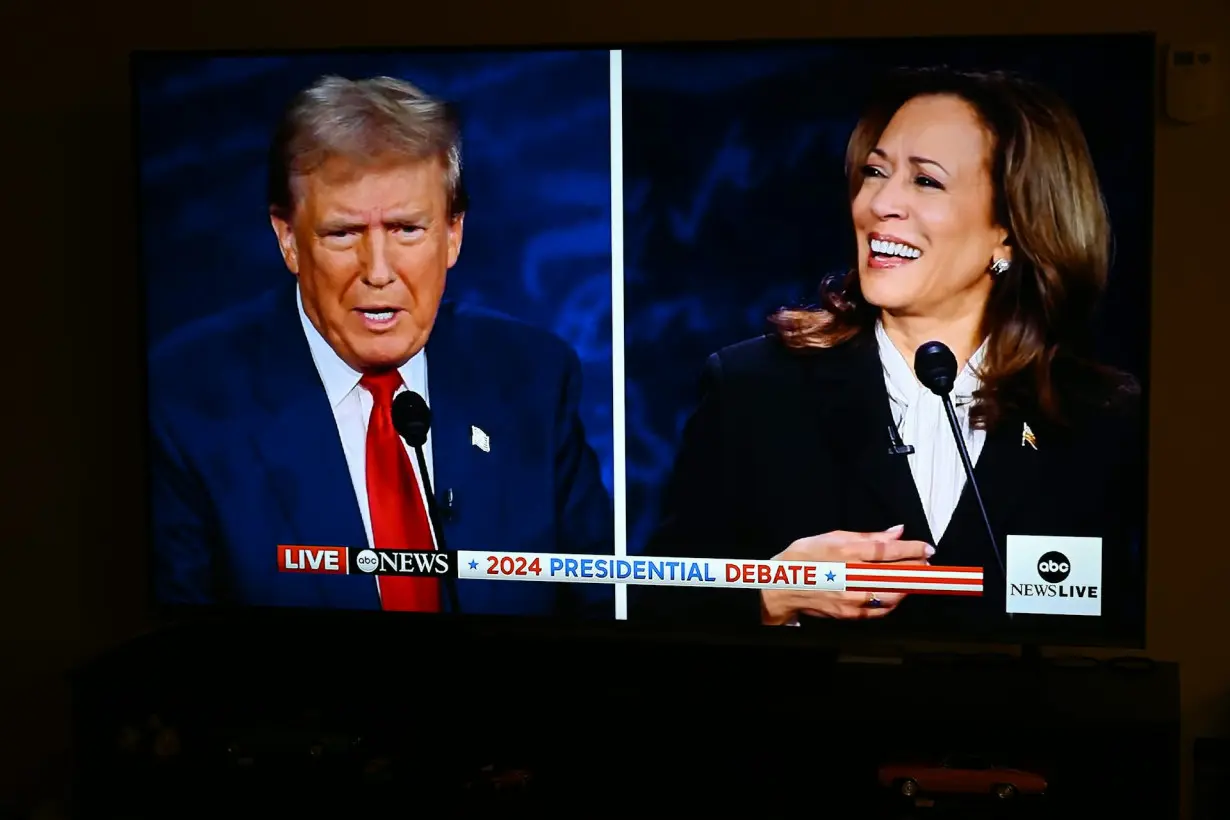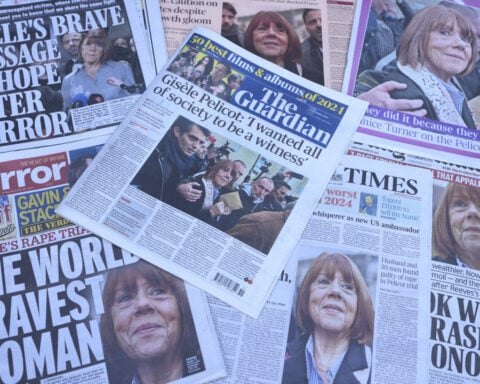Just when the summer uproar over Donald Trump calling his potential rival “Laffin’ Kamala” and “Cackling Copilot Kamala Harris” was beginning to subside, an apparent new round of attacks by Trump and other Republicans has emerged after their initial U.S. presidential debate.
The target – again – was Kamala Harris’ laugh.
Three days after the debate, for instance, Bruce Zuchowski, an Ohio sheriff, posted on his Facebook account that Harris was a “laughing hyena.” Zuchowski was subsequently barred from providing election security during in-person voting.
Conservative media commentators also have voiced their displeasure, calling Harris’ laugh “contemptuous,” “exaggerated” and “inappropriate.”
This is not surprising, given that Harris’ laughter was on full display during much of the nationally televised debate – and, worse, Trump was clearly the object of her unrelenting derision.
Much has been written already about the sexism and racism behind Trump’s contempt for Harris’ laugh.
But in a little-known, 1985 essay called “An Extravagance of Laughter,” celebrated American writer Ralph Ellison provided a sharp analysis of the subversive power of Black laughter in 1930s America.
Ellison’s essay, published in a 1986 collection “Going to the Territory,” still offers useful historical racial context for explaining Trump’s animus toward Harris. Among the stories Ellison tells: Black people once had to put their heads in a barrel to laugh because their laughter unnerved white Southerners.
The dangers of Black laughter
Best known for his 1952 novel “Invisible Man,” Ellison was one of America’s foremost social critics who confronted racism and white supremacy by telling the stories of alienation among everyday Black people searching for identity in a nation that deemed them inferior.
In “An Extravagance of Laughter,” Ellison began with an anecdote about attending a theater adaptation of Erskine Caldwell’s novel “Tobacco Road” in New York City in 1936. The popular play detailed the lives of destitute white sharecroppers during the Great Depression. The sharecroppers feared, among other things, losing their social status by dropping below the lower rung reserved for Black people in America.
While laughing uncontrollably at a comical scene in the play involving the antics of poor white Georgia farmers, Ellison became aware of the stir he was causing among the predominantly white audience.

For many white Americans, Black laughter was “a peculiar form of insanity suffered exclusively by Negroes, who in light of their social status and past condition of servitude were regarded as having absolutely nothing in their daily experience which could possibly inspire rational laughter,” Ellison explained.
As Ellison saw it, his laugh during the play was being construed as an affirmation of the Black buffoon stereotype.
As he described it, the white spectators were “catching fire and beginning to howl and cheer the disgraceful loss of control being exhibited” by a Black man.
Later in the essay, Ellison lampoons the use of “laughing barrels” in Southern towns, which he described as “huge whitewashed barrels labeled FOR COLORED, and into which any Negro who felt a laugh coming on was forced … to thrust his boisterous head.”
The intent of suppressing Black laughter, Ellison explained, was pro bono publico, or for the public good.
Stories of the use of barrels to block offensive Black laughter from public view have been well studied by scholars and are believed to be the origin of the expression “barrel of laughs.”
While the idea of the barrels may seem utterly ridiculous, Ellison understood them as an absurd strategy of containment for a not-so-absurd fear in post-Reconstruction and Jim Crow white America, when racial segregation was legal.
Black folks who laugh “turned the world upside down and inside out,” he explained.
And in so doing, Ellison wrote, Black laughter “in-verted (and thus sub-verted) tradition and thus the preordained and cherished scheme of Southern racial relationships was blasted asunder.”
In a 1983 letter celebrating Caldwell’s birthday, Ellison thanked the writer – “by giving artistic sanction to a source of comedy which in the interest of self-protection I had been forced to deny myself you had released me from three turbulent years of self-restraint.”
Flipping the script on who gets to laugh
The first time Trump found himself the object of Black laughter was during the 2011 White House correspondents’ dinner, where he was publicly and mercilessly roasted by a gleeful Barack Obama. The experience appeared to humiliate and infuriate Trump and is widely seen by political pundits as the catalyst for Trump’s entrance into the 2016 presidential race.
It is not surprising, then, to see his campaign resurrect the rhetoric that many deem to be racist to erode public confidence in Harris’ fitness for the office.
During the debate, Trump repeatedly accused Harris of “destroying the fabric of our country” with “insane” policies. Trump had previously called Harris “dumb as a rock” and “a radical left lunatic.”

These hearken to the long and shameful history of racist characterizations of Black Americans as menaces to society. They include depictions of unruly, newly emancipated Black men holding public office in D.W. Griffith’s 1915 “The Birth of a Nation” to Trump’s public call for the death penalty for the Black and Hispanic teens known as the Central Park Five in a full-page New York Times ad in 1989.
In that case, the teen boys were falsely accused of the brutal assault of a white New York jogger. They served years in prison before being exonerated by DNA and the confession of a convicted rapist and murderer.
America’s new racial and gender norms
Trump’s mockery of Harris’ laughter has not been successful in neutralizing her popularity.
Harris is widely regarded by political commentators as the winner of the debate, and the lasting impression is that of a glowering Trump repeatedly failing to put a stop to Harris’ mirthful expressions of incredulity.
Almost a century has passed since Ellison’s disruptive laugh occurred in a New York theater in 1936. In that time, both Obama and Harris have reordered traditional gender and racial norms by using Black laughter in the very public theater of U.S. presidential politics.

Betsy Huang does not work for, consult, own shares in or receive funding from any company or organization that would benefit from this article, and has disclosed no relevant affiliations beyond their academic appointment.
Source: The Conversation

 How to save a fentanyl victim: Key facts about naloxone
How to save a fentanyl victim: Key facts about naloxone
 Eight convicted in France over murder of teacher who showed Prophet caricature
Eight convicted in France over murder of teacher who showed Prophet caricature
 Death toll in German Christmas market car-ramming rises to five, more than 200 injured
Death toll in German Christmas market car-ramming rises to five, more than 200 injured
 Syrian Kurdish groups on the back foot as power balance shifts
Syrian Kurdish groups on the back foot as power balance shifts
 Syria's new rulers name foreign minister amid push for international relations
Syria's new rulers name foreign minister amid push for international relations
 Pakistan dismisses US official's warning over missile programme as unfounded
Pakistan dismisses US official's warning over missile programme as unfounded
 Russia's UK embassy denounces G7 loans to Ukraine as 'fraudulent scheme'
Russia's UK embassy denounces G7 loans to Ukraine as 'fraudulent scheme'
 Retailer Party City files for bankruptcy, will wind down 700 stores
Retailer Party City files for bankruptcy, will wind down 700 stores
 Philadelphia 76ers star Joel Embiid working through injuries and mental health struggles
Philadelphia 76ers star Joel Embiid working through injuries and mental health struggles
 Weightlifting Taiwan granny, 90, garners cheers, health benefits at gym
Weightlifting Taiwan granny, 90, garners cheers, health benefits at gym
 Soccer's top players have had enough, as FIFA's new super-sized tournament sparks a revolt
Soccer's top players have had enough, as FIFA's new super-sized tournament sparks a revolt
 A split image of Donald Trump and Kamala Harris during the presidential debate on Sept. 10, 2024.
A split image of Donald Trump and Kamala Harris during the presidential debate on Sept. 10, 2024.







